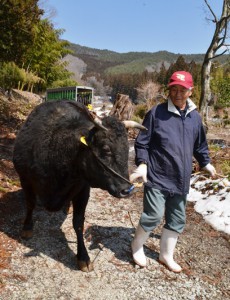On March 30, 49 breeding cows and calves were returned to the village of Katsurao in Fukushima Prefecture for the first time since the entire village was evacuated following the 2011 accident at the Fukushima No. 1 nuclear power plant.
It is the largest number of cows coming back to a municipality which had been designated as a no-go zone.
Cattle breeders, who had been conducting decontamination works ever since the evacuation order was lifted in the village in June, are happy to resume their business after six years. But at the same time, they are worried whether they can ship their calves without facing harmful rumors.
At a farm held by Sadashi Shinkai, 76, six cows were led into an empty cowshed with the sound of their hoofbeats clicking on the ground. “It feels great,” said Shinkai. “I’m determined to live with the cows from now on.”
Shinkai used to take care of nine cows, but had to sell three of them to make money to live on after he was forced to evacuate. He asked his breeder friend in the city of Tamura, Fukushima, to keep the rest of the cows, and commuted from a public housing for evacuees in the town of Miharu to take care of them.
After he decided to resume breeding in Katsurao, he visited his farm, which took him one and a half hours one way, to decontaminate the place and build feed boxes which he had to dispose of after the nuclear accident.
On the same day as the cows came back, Shinkai left the public housing and returned to his own house in Katsurao. “I’m willing to work hard, but I’m worried about harmful rumors,” Shinkai said. “Even if I resume breeding, I won’t be able to stay in business if the prices (of calves) go down.”
There were 96 cattle breeding farms in Katsurao before the disaster, but all of them had to evacuate after an evacuation order was issued for the whole village in April 2011 following the nuclear accident. In June 2016, the order was lifted in parts of the village, allowing breeders to prepare to return. Only seven farms actually returned with 49 cows and calves, beginning in late March through March 30.
Seventeen more farms still keep their cattle outside the village, and village officials say they hope to help them return through such measures as subsidizing renovation of cowsheds, in order to restore cattle breeding, the village’s main industry.
On March 31, evacuation orders were also to be removed in most of the town of Namie and the village of Iitate in Fukushima, both of which had been completely evacuated after the disaster.


